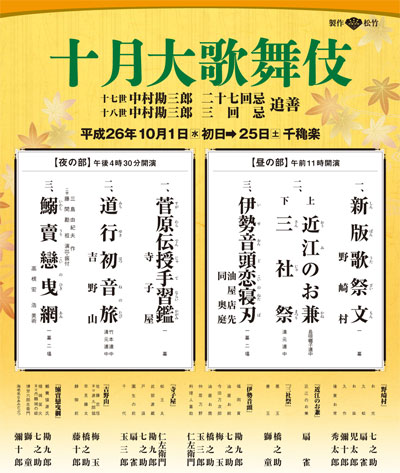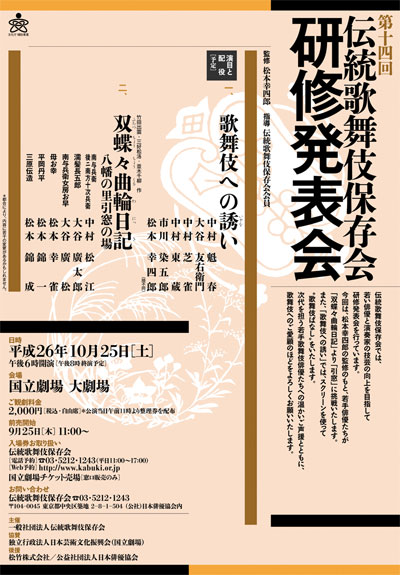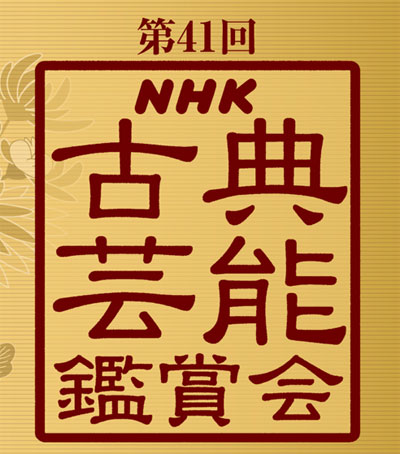| OCTOBER 2014 |
| Kabukiza (T˘ky˘) |  |
| Dates | 1 ~ 25 October 2014 (Jűgatsu ďkabuki) October Grand Kabuki |
| MatinÚe | |
| Evening |
Sugawara Denju Tenarai Kagami (Terakoya) |
| Casting |
Kataoka Nizaemon, Living National Treasure Sakata T˘jűr˘, Living National Treasure Band˘ Tamasabur˘, Nakamura Baigyoku, Nakamura Hashinosuke, Nakamura Senjaku, Nakamura Kankur˘, Nakamura Shichinosuke, Kataoka Hidetar˘, Band˘ Yajűr˘, Nakamura Shid˘, Kataoka Ichiz˘, Kataoka Kamez˘, Band˘ Shűch˘, Ichimura Kakitsu, Nakamura Kamenoj˘, Nakamura Kosanza, ďtani Keiz˘, Kataoka Matsunosuke, Band˘ Minosuke, Nakamura Kotar˘, Band˘ Shingo, Nakamura Toranosuke, Nakamura Tsurumatsu, Nakamura Kunio |
| Comments |
These programs commemorate the 26th anniversary (27th memorial service) and the 2nd anniversary (3rd memorial service) of late Nakamura Kanzabur˘ XVII and late Nakamura Kanzabur˘ XVIII.
|
 |
| Shinbashi Enbuj˘ (T˘ky˘) |
| Dates | 3 ~ 27 October 2014 (Jűgatsu Hanagata Kabuki) Ichikawa Ennosuke Funt˘ Renzoku K˘en October Young Actors Kabuki Ichikawa Ennosuke's Continuous Struggle Performances |
| MatinÚe |
Heike Nyogo no Shima (Shunkan) Kin no Zai Sarushima Dairi |
| Evening | |
| Casting |
Ichikawa Ennosuke, Nakamura Kinnosuke, Nakamura Karoku, Ichikawa Ukon, Band˘ Takesabur˘, Ichikawa Monnosuke, Ichikawa Omez˘, Nakamura Kikaku, Ichikawa Emisabur˘, Ichikawa Emiya, Ichikawa Juen, Ichikawa En'ya, Ichikawa Shun'en, Ichikawa K˘tar˘, Nakamura Yonekichi, Nakamura Hayato |
| Comments |
The Omodakaya guild strikes T˘ky˘ in full force and full regalia this month at the Shinbashi Enbuj˘ and in next month at the Meijiza [more details]. Led by Ichikawa Ennosuke, they perform large scale spectacular dramas full of keren which belong to the Ennosuke Shijűhassen (the Best 48 of Ennosuke) collection of plays [more details] or classics for the Omodakaya guild or the Ichikawa clan. These performances are called Ichikawa Ennosuke Funt˘ Renzoku K˘en, literally Ichikawa Ennosuke's Continuous Struggle Performances.
|
 |
| National Theatre (T˘ky˘) |
| Dates | 4 ~ 27 October 2014 |
| Program |
|
| Casting |
Matsumoto K˘shir˘, Ichikawa Somegor˘, Nakamura Shibajaku, Nakamura Kaishun, ďtani Tomoemon, Nakamura T˘z˘, Ichikawa Komaz˘, Nakamura Matsue, Sawamura S˘nosuke, Matsumoto Kingo, ďtani Hirotar˘, ďtani Hiromatsu |
| Comments |
"Futatsu Ch˘ch˘ Kuruwa Nikki" is staged in a t˘shi ky˘gen production (4 acts; 5 scenes) at the National Theatre. The rarely-staged "Shinkiyomizu" is the opening act. Others scenes are the same ones as the January 2003 production in the same theater: "Sum˘ba", "Komeya", "Nanba Ura Koroshi" and "Hikimado".
|
 |
| Dates | 25 October 2014 (Dent˘ Kabuki Hozonkai Kenshű Happy˘kai) Training Recital of the Organization for the Preservation of Kabuki |
| Program |
Kabuki he no Izanai |
| Casting |
Nakamura Matsue, ďtani Hirotar˘, ďtani Hiromatsu, Matsumoto K˘jaku, Matsumoto Kin'ichi, Matsumoto Kinsei |
| Comments |
14th Training Recital at the National Theatre produced by the Organization for the Preservation of Kabuki. "Kabuki he no Izanai" (literally "Invitation to Kabuki") is a stage speech delivered by Matsumoto K˘shir˘, Nakamura Shibajaku, Ichikawa Somegor˘, Nakamura Kaishun, Nakamura T˘z˘ and ďtani Tomoemon.
|
 |
| Nagoya (NTK Hall) |
| Dates | 5 ~ 27 October 2014 (Kinshű Nagoya Kaomise) Autumn Brocade Nagoya Face-Showing Program |
| MatinÚe | |
| Evening | |
| Casting |
Living National Treasure Onoe Kikugor˘, Nakamura Tokiz˘, Onoe Kikunosuke, Ichikawa Sadanji, Onoe Sh˘roku, Ichikawa Danz˘, Kawarasaki Gonjűr˘, Band˘ Kamesabur˘, Band˘ Kametoshi, Nakamura Baishi, Nakamura Mantar˘, Onoe Ukon |
| Comments |
The October kaomise programs in Nagoya. As the Misonoza closed in Spring 2013, these programs are staged at the Nihon Tokushu T˘gy˘ Shimin Kaikan for the second time, a venue commonly called NTK Hall in Nagoya.
|
 |
| Sh˘chikuza (ďsaka) |
| Dates | 3 ~ 27 October 2014 (Jűgatsu Hanagata Kabuki) October Young Actors Kabuki |
| Program |
GOEMON-Ishikawa Goemon |
| Casting |
Kataoka Ainosuke, Nakamura Kanjaku, Imai Tsubasa, Ichimura Manjir˘, Kamimura Kichiya, Nakamura Kazutar˘, Nakamura Tanenosuke |
| Comments |
A dance-drama first performed in 2011 presenting the mysterious life of Ishikawa Goemon (Kataoka Ainosuke) with a new perspective. It is the time after the unification of Japan by Toyotomi Hideyoshi (Nakamura Kanjaku) in the 16th century. There are several cathedrals seen in each place of Japan as a few decades have passed since Christianity has first been missioned in Japan. Ishida no Tsubone (Kamimura Kichiya), a daughter of Akechi Mitsuhideĺs chief retainer Shioden Tajima-no-Kami, hates Hideyoshi and seeks opportunity to avenge her father on him. As she learns Christianity from Father Calderon (Imai Tsubasa), she has come to forget her hatred against Hideyoshi. Love has grown between her and Calderon, and Tomoichi is born between them. Calderon resigns as a priest because he has broken the law as a priest, and chooses to live together with his wife and son. 7 years later Hideyoshi prohibits Christianity to be propagated in Japan. Calderon is banished from Japan and goes back to Spain. Hideyoshi wants to make her his own and summons her to his palace Jurakudai, since he has fancied her for years. She tries in vain to kill him and dies. Having lost his parents, Tomoichi grows up to be a robber and calls himself Ishikawa Goemon who causes a great sensation in Japan. He watches eagerly for a chance to avenge his parents on Toyotomi Hideyoshi. Goemon outwits Hideyoshi and succeeds in freeing Izumo no Okuni (Nakamura Kazutar˘) from him. She is Nagoya Sanzaĺs wife and a popular dancer in Ky˘to. It turns out that Sanza (Kamimura Kichiya) is a son of Akechi Mitsuhideĺs retainer Yasuda Sakubŕ. Goemon, Okuni and Sanza cooperate to defeat their common enemy Hideyoshi. Okuni takes great pains how she becomes the center of attention among people. Goemon teaches her flamenco the dance of his fatherĺs country as a hint for the new dance. But Goemon is being besieged from all sides. Enjoy a novel Kabuki dance which has taken in flamenco. |
| NHK Hall (T˘ky˘) | |
| Dates | 28 October 2014 (Koten Gein˘ Kansh˘ Kai) |
| Program |
Keisei Hangonk˘ (Domo Mata) |
| Casting |
Living National Treasure Nakamura Kichiemon, Nakamura Shibajaku, Nakamura Karoku, Nakamura Matagor˘, Nakamura Kash˘, Nakamura Kamenoj˘ |
| Comments |
41st edition of Koten Gein˘ Kansh˘ Kai (literally the "Classics Entertainment Appreciation Association"), a yearly performance produced by the National TV network NHK. The program includes one ky˘gen, one Kabuki play, one traditional dance and traditional music.
|
 |
|
|||
| Dates | 29 October ~ 2 November 2014 Band˘ Tamasabur˘ Special Dance Performances |
||
| Program |
Kosunoto Aoi no Ue Kane-ga-Misaki |
||
| Casting |
Living National Treasure Band˘ Tamasabur˘ |
||
| Comments |
A special Buy˘ program starring the amazing Living National Treasure onnagata Band˘ Tamasabur˘ in Yamaga at the Yachiyoza, a traditional wooden-built theater. The 3 dances are traditional Jiutamai dances.
|
||
| Nihonbashi Mitsui Hall (T˘ky˘) |
| Dates | 11 ~ 26 October 2014 (JAPAN THEATER) |
| Program |
Heike Monogatari Otokodate Hana no Yoshiwara |
| Casting | |
| Comments |
The first item of this program is a reading session of extracts from the "Heike Monogatari". The second item is the staging of the dance-drama "Otokodate Hana no Yoshiwara". |
|
|||
| Dates | 29 October ~ 2 November 2014 (JAPAN THEATER) | ||
| Program |
Heike Monogatari Otokodate Hana no Yoshiwara |
||
| Casting | |||
| Comments |
The first item of this program is a reading session of extracts from the "Heike Monogatari". The second item is the staging of the dance-drama "Otokodate Hana no Yoshiwara". |
||
|
|
| Contact | Main | Top | Updates | Actors | Plays | Playwrights | Programs | Links | FAQ | Glossary | Chronology | Illustrations | Prints | Characters | Derivatives | Theaters | Coming soon | News |